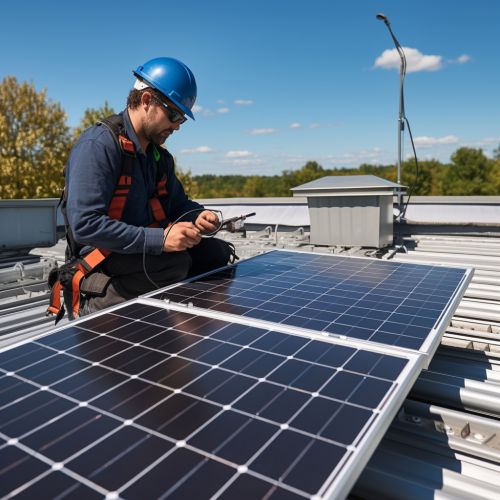Photovoltaic system
Introduction
A Photovoltaic system or PV system is a power system designed to supply usable solar power by means of Photovoltaics. It consists of an arrangement of several components, including solar panels to absorb and convert sunlight into electricity, a solar inverter to change the electric current from DC to AC, as well as mounting, cabling, and other electrical accessories to set up a working system.


Components
A photovoltaic system typically includes an array of photovoltaic modules, an inverter, a battery pack for energy storage, interconnection wiring, and optionally a solar tracking mechanism.
Photovoltaic Modules
Photovoltaic modules, commonly known as solar panels, are the main component of a photovoltaic system. They are composed of photovoltaic cells that convert sunlight into electricity. The cells are made from semiconductors, typically silicon, which absorb the sunlight and convert it into a flow of electrons, or electric current.


Inverter
The inverter is a critical component of a photovoltaic system. It converts the direct current (DC) output of the photovoltaic modules into alternating current (AC) that can be fed into a commercial electrical grid or used by a local, off-grid electrical network.
Battery Pack
In some photovoltaic systems, a battery pack is used for energy storage. The battery stores the excess power produced by the solar panels during the day and releases it as needed, such as during the night or during periods of high demand.


Solar Tracking Mechanism
A solar tracking mechanism can be included in a photovoltaic system to increase its efficiency. The tracker adjusts the orientation of the solar panels to follow the sun as it moves across the sky, maximizing the amount of sunlight that the panels can absorb.


Design and Installation
The design and installation of a photovoltaic system can be complex and requires careful planning. Factors to consider include the location and orientation of the solar panels, the size of the system, the type of photovoltaic cells used, and the integration of the system with the existing electrical grid.
Location and Orientation
The location and orientation of the solar panels are critical factors in the performance of a photovoltaic system. The panels should be installed in a location that receives maximum sunlight throughout the day. The optimal orientation for the panels is typically towards the equator.
System Size
The size of the photovoltaic system is determined by the amount of power that is needed. The system size is usually expressed in terms of its peak power output, or the maximum amount of power it can produce under optimal conditions.


Type of Photovoltaic Cells
There are several types of photovoltaic cells available, each with its own advantages and disadvantages. The most common types are monocrystalline, polycrystalline, and thin-film cells.
Integration with the Electrical Grid
The integration of a photovoltaic system with the existing electrical grid is a complex process that requires careful planning and coordination with the local utility company.
Performance and Efficiency
The performance and efficiency of a photovoltaic system can be affected by a variety of factors, including the quality of the photovoltaic cells, the orientation and tilt of the solar panels, the presence of shading, and the efficiency of the inverter and other components.


Environmental Impact
While photovoltaic systems have a lower environmental impact compared to conventional power generation methods, they are not completely free of environmental concerns. The production of photovoltaic cells involves the use of hazardous materials and generates waste. However, the environmental impact is significantly offset by the lack of greenhouse gas emissions during operation.
Economic Considerations
The economic viability of a photovoltaic system depends on a variety of factors, including the cost of the system, the amount of sunlight available, the cost of electricity, and the availability of government incentives.
